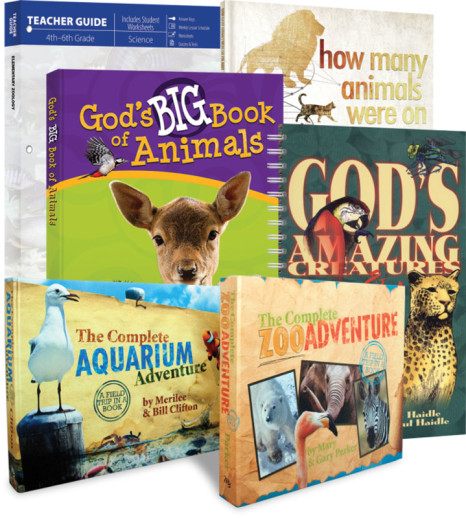We use cookies to make your experience better. To comply with the new e-Privacy directive, we need to ask for your consent to set the cookies. Learn more.
Elementary Zoology Curriculum Pack
This package includes the Elementary Zoology Teacher Guide, as well as the following student books: God's Amazing Creatures and Me!, How Many Animals Were on the Ark?, The Complete Aquarium Adventure, The Complete Zoo Adventure, and God's Big Book of Animals.
Zoology is the study of life, often connected with biology and focused on animals, which is why we have those places called "zoos" all across the country. However, while the secular focus of zoology is on life origins and evolution, this course celebrates the wonder of God's creation and His unique design of all life on earth. This course has been developed to enhance learning about the diverse and amazing animals we see in our world. From the tiniest to the largest, you will be exploring what makes them unique as you celebrate their place in the world God created. Although the material can be modified for your own educational purposes, either on an elementary or more advanced level, it has been organized here to fit a one-year course.
Combines the study of both land animals and sea creatures, complete with trips to the zoo and aquarium. Our unique package gives the educator an easy-to-use daily plan to turn these wonderful resources into a complete year of learning your student is going to love!
God's Big Book of Animals
Let's learn all about His wonderful creatures--where they are, what they eat, and how they live. From the birds that fly in the sky to the mammals that walk on the ground to the fishes that swim in the sea, you'll read about 60 of God's amazing creatures, from the tiny shrew and poison dart frog to the mighty elephant and great white shark. Enjoy a book that makes studying animals both fun and educational!
God's Amazing Creatures & Me!
A creation devotional for children ages 6-10, which shows detailed, pen and ink illustrations of animals - mammals, insects, birds - paired with a description of each, then an application for the youthful reader. In exploring God's awesome nature, it is helpful for children to understand God's design for them. For example, just as the monarch butterfly emerges from a cocoon to soar to heights above the clouds, so too can we all rest in the knowledge that God has made each of us special, and He has great love and a plan for us.
How Many Animals were on the Ark
How was it possible for Noah to bring aboard 2 million animals on the Ark, or were there perhaps less than 7,000? Helps answer one of the most difficult questions concerning the long voyage of the historical Ark!
The Complete Aquarium Adventure
Learn about amphibians, aquatic birds, fish, mammals, reptiles, pelicans, penguins, clownfish, eels, sea dragons, jellyfish, sharks, coral octopus, sting rays, and even whale sharks. Get all hands on deck and prepare to cast off! Your nautical-themed adventure is about to begin! Get your toes wet as you learn.
The Complete Zoo Adventure
The Complete Zoo Adventure sets the stage for learning with "Before the Zoo" preparations, gives you the tools you need for an awesome "At the Zoo" experience, and then continues to deepen the understanding of God's Creation with fabulous "After the Zoo" activities. Truly a complete guide like no other!
| Product Format: | Other |
|---|---|
| Brand: | Master Book Publishers |
| Grades: | 4-6 |
| ISBN: | 9781683442691 |
| Length in Inches: | 14.625 |
| Width in Inches: | 11.5 |
| Height in Inches: | 6.5 |
| Weight in Pounds: | 12.3 |

